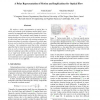Free Online Productivity Tools
i2Speak
i2Symbol
i2OCR
iTex2Img
iWeb2Print
iWeb2Shot
i2Type
iPdf2Split
iPdf2Merge
i2Bopomofo
i2Arabic
i2Style
i2Image
i2PDF
iLatex2Rtf
Sci2ools
CVPR
2011
IEEE
2011
IEEE
A Polar Representation of Motion and Implications for Optical Flow
We explore a polar representation of optical flow in which each element of the brightness motion field is represented by its magnitude and orientation instead of its Cartesian projections. This seemingly small change in representation provides more direct access to the intrinsic structure of a flow field, and when used with existing variational inference procedures it provides a framework in which regularizers can be intuitively tailored for very different classes of motion. Our evaluations reveal that a flow estimation algorithm that is based on a polar representation can perform as well or better than the state-of-the-art when applied to traditional optical flow problems concerning camera or rigid scene motion, and at the same time, it facilitates both qualitative and quantitative improvements for non-traditional cases such as fluid flows and specular flows, whose structure is very different.
| Added | 08 Apr 2011 |
| Updated | 29 Apr 2011 |
| Type | Journal |
| Year | 2011 |
| Where | CVPR |
| Authors | Yair Adato, Todd Zickler, Ohad Ben-Shahar |
Comments (0)

